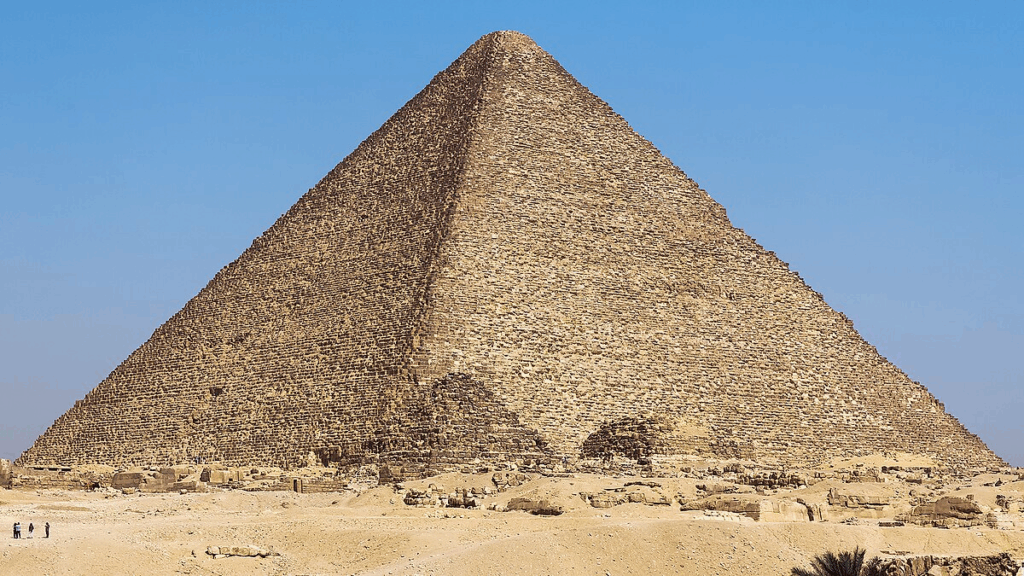Rewriting History: The Great Pyramid’s Hidden Truth May Shatter an Ancient Myth
For generations, the Great Pyramid of Giza stood as both a symbol of ancient wonder and a haunting reminder of a brutal narrative: that it was built on the backs of 100,000 enslaved laborers, toiling under the sun, their lives lost in service to a pharaoh’s ego. But new discoveries are now dismantling that long-accepted myth—and revealing a vastly different story hidden deep within the stone heart of the pyramid itself.

Thanks to a bold new exploration led by Egyptologist Dr. Zahi Hawass, aided by modern technology and an unlikely benefactor—podcaster Matt Beall—we may finally be closer to understanding who really built the Great Pyramid, how they did it, and why.
Ancient Graffiti, Modern Revelations
In a series of chambers long sealed above the King’s Chamber—places never meant to be seen again once construction was complete—Dr. Hawass and his team uncovered inscriptions left behind by the builders themselves. These weren’t random scratches or elite hieroglyphs—they were the names of worker crews from over 3,000 years ago. And what they reveal is astonishing.
These were not slaves, but organized labor teams with specific roles, responsibilities, and even titles like “Overseer of the Side of the Pyramid” and “Craftsman.” They were artisans, engineers, and stoneworkers—respected in life and honored in death.
Their tombs, found just south of the pyramid, include statues and grave goods that suggest reverence, not subjugation. “Slaves don’t get buried with honor beside a king,” Dr. Hawass remarked during an interview on the Matt Beall Limitless podcast. “These were elite workers in their own right.”
Ramps, Sleds, and a City Beneath the Sand
The discovery of a ramp system—rudimentary yet effective, made of mudbrick and limestone chippings—offers crucial clues into how the 2.3 million blocks that make up the pyramid were transported. One quarry, just 1,000 feet away, is believed to have been the main source of the stone, hauled across the desert on wooden sleds.
Nearby, an entire workers’ village, dubbed “the Lost City of the Builders,” has been unearthed. It features massive bakeries, fish-sorting stations, housing quarters, and storage facilities—evidence of a logistical operation that fed, sheltered, and organized thousands. Meat bones from cattle and goats indicate a diet far richer than the old tales of onions and bread.
“We found remains of enough meat to feed 10,000 people a day,” said Dr. Mark Lehner, a colleague of Hawass and expert on the workers’ settlement. “This was not a prison camp—it was a functioning, complex society built around one purpose: to construct the pyramid.”
Inscriptions That Can’t Be Faked
The inscriptions discovered in the hidden chambers add further weight to the theory that the workers took pride in their efforts. These markings, etched in red ochre, are nearly inaccessible—requiring a 45-foot climb and a crawl through narrow stone corridors. Their location alone makes the idea of forgery virtually impossible.
“These were messages between builders, not for public display,” Dr. Hawass explained. “Their authenticity is beyond doubt—they’re the voices of the men who built the greatest monument in history.”
The Big Void: What Lies Inside?
But perhaps the greatest mystery is still waiting to be unlocked. A strange anomaly discovered in 2017 using cosmic-ray scanning—a space within the pyramid now known as the “Big Void”—has sparked intense speculation. Lying above the Grand Gallery, this space has never been entered, its purpose unknown.
With funding from Matt Beall, Dr. Hawass plans to deploy a micro-robot through a borehole to explore the chamber in 2026—potentially the first modern expedition of its kind inside the pyramid’s structure.
Could this void contain the true burial chamber of Pharaoh Khufu, whose body has never been found? Or is it something else entirely—perhaps a symbolic structure, an astronomical observatory, or a forgotten secret chamber sealed by ancient hands for eternity?
Even Beall remains skeptical: “No pharaoh has ever been found inside a major pyramid. But if there’s a chance to answer that question definitively, we have to try.”
Conclusion: A Monument Reclaimed
The story of the Great Pyramid is no longer just about architectural genius or ancient superstition. It is now the story of real people—craftsmen, architects, and workers—who lived, labored, and left behind whispers in stone that are only now being understood.
From the graffiti scrawled in the pyramid’s hidden ceilings to the skeletal remains of a thriving workers’ city beneath the desert floor, a new image emerges: one of ingenuity, structure, and honor—not chains.
As preparations begin for the robotic expedition into the Big Void, the world waits, once again, on the edge of discovery. Whatever secrets still lie hidden in the Great Pyramid, one thing is certain: history is being rewritten, not with chisel and hammer, but with truth.
